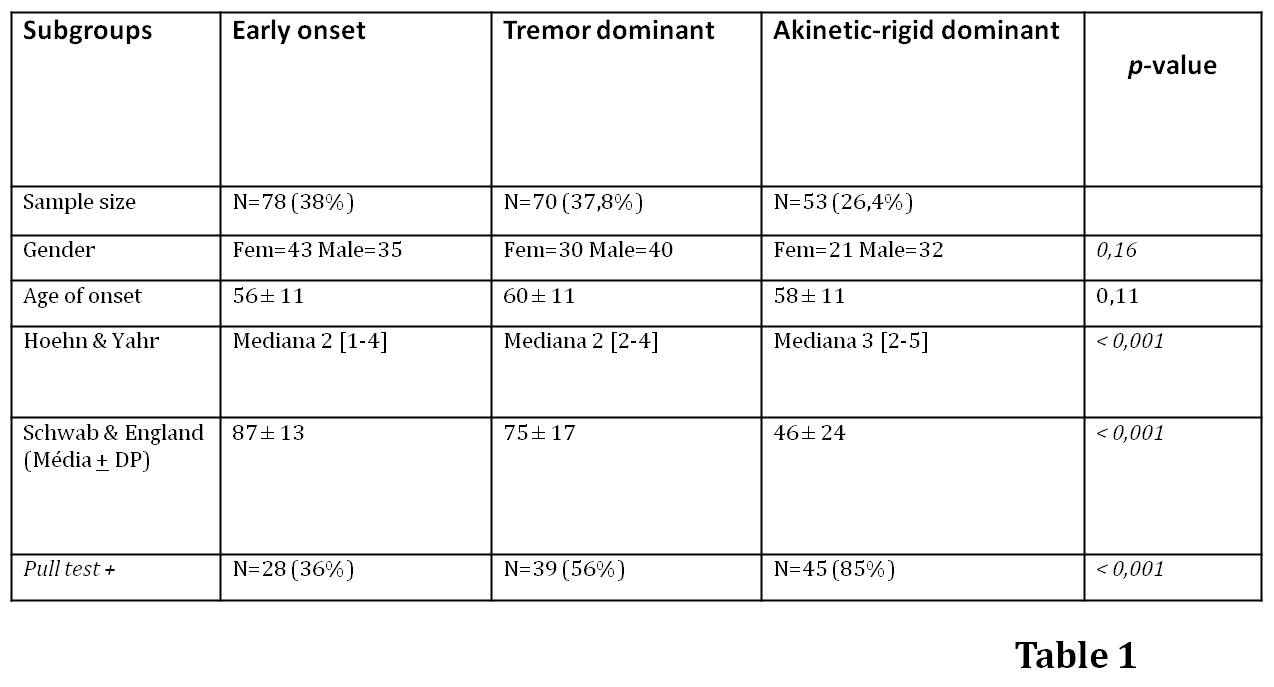Session Information
Date: Wednesday, June 7, 2017
Session Title: Phenomenology and Clinical Assessment Of Movement Disorders
Session Time: 1:15pm-2:45pm
Location: Exhibit Hall C
Objective: To correlate Parkinson’s disease (PD) subtypes with a clinical severity in a Brazilian population sample.
Background: Current studies have shown that PD may comprise different clinical subtypes. Systematic review has failed to demonstrate a single subgroup classification which may be applied across different populations (1). Therefore, the characterization of local populations help clinicians to provide better management to different patients.
Methods: Patients (N=201) from a reference center in the Southern region of Brazil (Porto Alegre) were evaluated between 2006 and 2014. After signing consent forms, all participants underwent MDS Unified Parkinson’s Disease Rating Scale (MDS-UPDRS), Schwab & England (SE) and Hoehn & Yahr (HY) testing. A k-means CA of UPDRS motor scores, age of onset, SE, and HY was performed. A subsequent post hoc testing (chi-square, Kruskal-Wallis, and One-Way ANOVA) was undertaken to compare the patient subgroups. Statistical analysis was conducted using IBM SPSS v.18.
Results: Hierarchical analysis identified three clusters (Table 1). The first group (N=78; 38%) was characterized by early age of onset (56±11), less severe progression (median HY = 2), and less impact on daily life activities (SE = 87 + 13). The second group (N = 70; 34.8%) was found to have later age of onset (60±11), tremor dominant, and moderate progression and impact on daily life activities (median HY = 2; SE = 75±17). The third group (N = 53; 26.4%), age of onset similar to the second (58±11), more prevalent akinetic-rigid symptoms, and the most severe progression and impact on daily life activities (median HY = 3; SE = 46±24). All motor symptoms were statistically different among the groups (p < 0,01). The SE and HY scales were also statistically different (p < 0,001). The difference of age of onset among subgroups was not significant (p = 0,11).
Conclusions: Our findings highlight that PD does not comprise a single clinical entity. Identifying subgroups helps predict progression and determine those patients who are likely to have more debilitating symptoms. It may also help personalize treatments to each particular set of patients.
References: 1) van Rooden SM, Heiser WJ, Kok JN, Verbaan D, van Hilten JJ, Marinus J. The identification of Parkinson’s disease subtypes using cluster analysis: a systematic review. Mov Disord. 2010 Jun 15;25(8):969-78.
To cite this abstract in AMA style:
C. Batista, M. Medeiros, C. Rieder, A. Schuh. Parkinson’s disease subtypes correlate with clinical severity: a Brazilian population study [abstract]. Mov Disord. 2017; 32 (suppl 2). https://www.mdsabstracts.org/abstract/parkinsons-disease-subtypes-correlate-with-clinical-severity-a-brazilian-population-study/. Accessed January 5, 2026.« Back to 2017 International Congress
MDS Abstracts - https://www.mdsabstracts.org/abstract/parkinsons-disease-subtypes-correlate-with-clinical-severity-a-brazilian-population-study/

